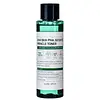What's inside
What's inside
 Key Ingredients
Key Ingredients

 Benefits
Benefits

 Concerns
Concerns

No concerns
 Ingredients Side-by-side
Ingredients Side-by-side

Water
Skin ConditioningButylene Glycol
HumectantDipropylene Glycol
HumectantGlycerin
HumectantNiacinamide
SmoothingMelaleuca Alternifolia Leaf Water
AntimicrobialPolyglyceryl-4 Caprate
EmulsifyingCarica Papaya Fruit Extract
Skin ConditioningLens Esculenta Seed Extract
Skin ProtectingHamamelis Virginiana Extract
AntiseborrhoeicNelumbo Nucifera Flower Extract
Skin ConditioningSwiftlet Nest Extract
Skin ConditioningSodium Hyaluronate
HumectantFructan
Skin ConditioningAllantoin
Skin ConditioningAdenosine
Skin ConditioningHydroxyethyl Urea
HumectantXylitol
HumectantSalicylic Acid
MaskingLactobionic Acid
BufferingCitric Acid
BufferingSodium Citrate
Buffering1,2-Hexanediol
Skin ConditioningBenzyl Glycol
SolventEthylhexylglycerin
Skin ConditioningRaspberry Ketone
MaskingMentha Piperita Oil
MaskingWater, Butylene Glycol, Dipropylene Glycol, Glycerin, Niacinamide, Melaleuca Alternifolia Leaf Water, Polyglyceryl-4 Caprate, Carica Papaya Fruit Extract, Lens Esculenta Seed Extract, Hamamelis Virginiana Extract, Nelumbo Nucifera Flower Extract, Swiftlet Nest Extract, Sodium Hyaluronate, Fructan, Allantoin, Adenosine, Hydroxyethyl Urea, Xylitol, Salicylic Acid, Lactobionic Acid, Citric Acid, Sodium Citrate, 1,2-Hexanediol, Benzyl Glycol, Ethylhexylglycerin, Raspberry Ketone, Mentha Piperita Oil
Water
Skin ConditioningPentylene Glycol
Skin ConditioningCamellia Sinensis Leaf
PerfumingGlycerin
HumectantSodium Hyaluronate
HumectantHydrolyzed Hyaluronic Acid
HumectantHyaluronic Acid
HumectantPropanediol
SolventBetaine
HumectantXanthan Gum
EmulsifyingArtemisia Annua Extract
MaskingCamellia Sinensis Leaf Extract
AntimicrobialAzadirachta Indica Leaf Extract
Skin ConditioningPolyglutamic Acid
Skin ConditioningCitric Acid
BufferingGlyceryl Caprylate
EmollientCentella Asiatica Extract
CleansingSqualane
EmollientWater, Pentylene Glycol, Camellia Sinensis Leaf, Glycerin, Sodium Hyaluronate, Hydrolyzed Hyaluronic Acid, Hyaluronic Acid, Propanediol, Betaine, Xanthan Gum, Artemisia Annua Extract, Camellia Sinensis Leaf Extract, Azadirachta Indica Leaf Extract, Polyglutamic Acid, Citric Acid, Glyceryl Caprylate, Centella Asiatica Extract, Squalane
 Reviews
Reviews

Ingredients Explained
These ingredients are found in both products.
Ingredients higher up in an ingredient list are typically present in a larger amount.
Citric Acid is an alpha hydroxy acid (AHA) naturally found in citrus fruits like oranges, lemons, and limes.
Like other AHAs, citric acid can exfoliate skin by breaking down the bonds that hold dead skin cells together. This helps reveal smoother and brighter skin underneath.
However, this exfoliating effect only happens at high concentrations (20%) which can be hard to find in cosmetic products.
Due to this, citric acid is usually included in small amounts as a pH adjuster. This helps keep products slightly more acidic and compatible with skin's natural pH.
In skincare formulas, citric acid can:
While it can provide some skin benefits, research shows lactic acid and glycolic acid are generally more effective and less irritating exfoliants.
Most citric acid used in skincare today is made by fermenting sugars (usually from molasses). This synthetic version is identical to the natural citrus form but easier to stabilize and use in formulations.
Read more about some other popular AHA's here:
Learn more about Citric AcidGlycerin is already naturally found in your skin. It helps moisturize and protect your skin.
A study from 2016 found glycerin to be more effective as a humectant than AHAs and hyaluronic acid.
As a humectant, it helps the skin stay hydrated by pulling moisture to your skin. The low molecular weight of glycerin allows it to pull moisture into the deeper layers of your skin.
Hydrated skin improves your skin barrier; Your skin barrier helps protect against irritants and bacteria.
Glycerin has also been found to have antimicrobial and antiviral properties. Due to these properties, glycerin is often used in wound and burn treatments.
In cosmetics, glycerin is usually derived from plants such as soybean or palm. However, it can also be sourced from animals, such as tallow or animal fat.
This ingredient is organic, colorless, odorless, and non-toxic.
Glycerin is the name for this ingredient in American English. British English uses Glycerol/Glycerine.
Learn more about GlycerinSodium Hyaluronate is hyaluronic acid's salt form. It is commonly derived from the sodium salt of hyaluronic acid.
Like hyaluronic acid, it is great at holding water and acts as a humectant. This makes it a great skin hydrating ingredient.
Sodium Hyaluronate is naturally occurring in our bodies and is mostly found in eye fluid and joints.
These are some other common types of Hyaluronic Acid:
Learn more about Sodium HyaluronateWater. It's the most common cosmetic ingredient of all. You'll usually see it at the top of ingredient lists, meaning that it makes up the largest part of the product.
So why is it so popular? Water most often acts as a solvent - this means that it helps dissolve other ingredients into the formulation.
You'll also recognize water as that liquid we all need to stay alive. If you see this, drink a glass of water. Stay hydrated!
Learn more about Water